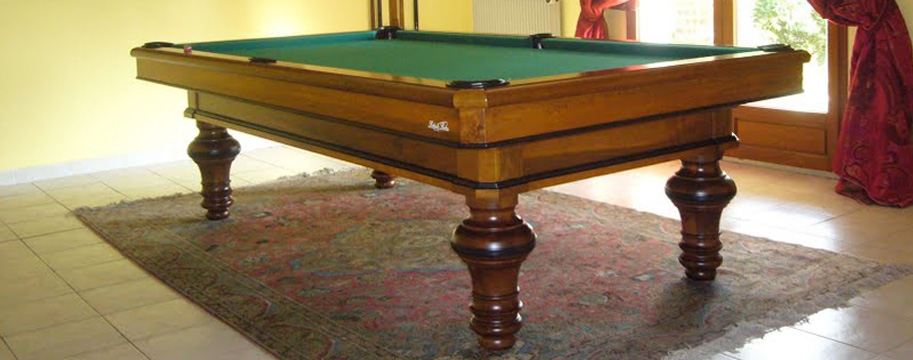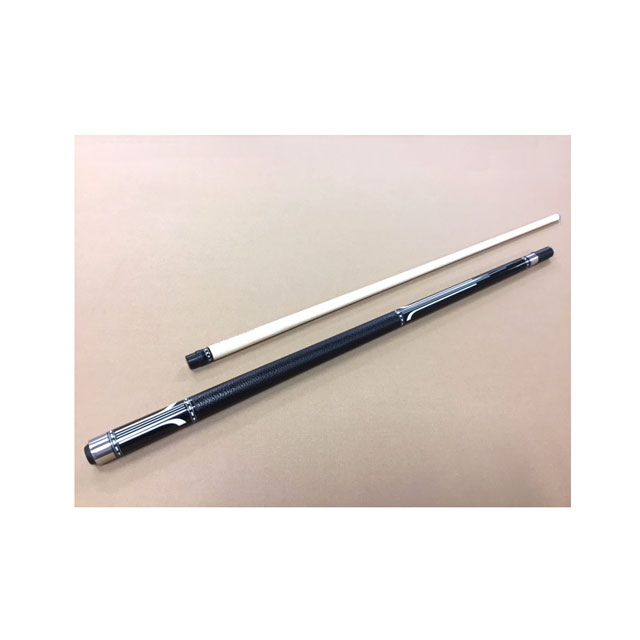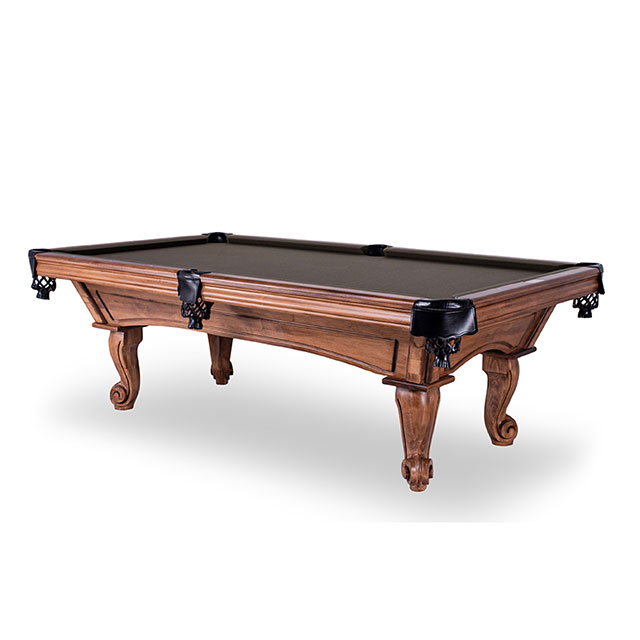Billiard and Pool History
The following is an excerpt from a book written by well known “Billiards” historian and author, Mike Shamos.
A Game that has Stood the Test of Time. The History of Billiards is Rich and Colorful.
The History of billiards is long and very rich. The game has been played by kings and commoners, presidents, mental patients, ladies, gentlemen, and hustlers alike. It evolved from a lawn game similar to the croquet played some-time during the 15th century in Northern Europe and probably in France. Play moved indoors to a wooden table with green cloth to simulate grass, and a simple border was placed around the edges. The balls were shoved, rather than struck, with wooden sticks called “maces.” The term “billiard” is derived from French, either from the word “billart”, one of the wooden sticks, or “bille”, a ball.

Most of our information about early billiards comes from accounts of playing by royalty and other nobles. It has been know as the “Noble Game of Billiards” since the early 1800’s but there is evidence that people from all walks of life played the game since its inception. In 1600, the game was familiar enough to the public that Shakespeare mentioned it in Antony and Cleopatra. Seventy-five years later, the first book of billiards rules remarked of England that there were few “few Tones of note therein which hath not a public Billiard-Table.”
The cue stick was developed in the late 1600’s. When the ball lay near a rail, the mace was very inconvenient to use because of its large head. In such a case, the players would turn the mace around and use its handle to strike the ball. The handle was called a “queue” meaning “tail” from which we get the word “cue.” For a long time only men were allowed to use the cue; women were forced to use the mace because it was felt they were more likely to rip the cloth with the shaper cue.

Billiard Game

Tables originally had flat walls for rails and their only function was to keep the balls from falling off. They resembled river banks and even used to be called “banks”. Players discovered that balls could bounce off the rails and began deliberately aiming at them. Thus a “bank shot” is one in which a ball is made to rebound from a cushion as part of the shot.
Billiard equipment improved rapidly in England after 1800, largely because of the Industrial Revolution. Chalk was used to increase friction between the ball and the cue stick even before cues had tips. The leather cue tip, with which a player can apply side-spin to the ball, was perfected by 1823. Visitors from England showed Americans how use spin, which explains why it is called “English” in the United States but nowhere else. (The British themselves refer to it as “side”.) The two-piece cue arrived in 1829. Slate became popular as a material for table beds around 1835. Goodyear discovered vulcanization of rubber in 1839 and by 1845 it was used to make billiard cushions. A two-to-one ratio of length to width became standard in the 18th century. Before then, there were no fixed table dimensions. By 1850, the billiard table had essentially evolved into its current form.
The dominant billiard game in Britain from about 1770 until the 1920’s was English Billiards, played with three balls and six pockets on a large rectangular table. The British billiard tradition is carried on today primarily through the game of snooker, a complex and colorful game combining offensive and defensive aspects and played on the same equipment as English Billiards but with 22 balls instead of three. The British appetite for snooker is approached only by the American passion for baseball; it is possible to see a snooker competition every day in Britain.
American Billiard Game
The dominant American billiard game until the 1870’s was American Four-Ball Billiards, usually played on a large (11 or 12-foot), four-pocket table with four balls – two white and two red. It was a direct extension English Billiards. Points were scored by pocketing balls, scratching the cue ball, or by making caroms on two or three balls. A “carom” is the act of hitting two object balls with the cue ball in one stroke. With many balls, there were many different ways of scoring and it was possible to make up to 13 pints on a single shot. American Four-Ball produced two offspring, both of which surpassed it in popularity by the 1870’s. One, simple caroms played with three balls on a pocketless table, is something known as “Straight rail”, the forerunner of all carom games. The other popular game was American Fifteen-Ball Pool, the predecessor of modern pocket billiards.
Pool Tables
The word “pool” means a collective bet, or ante. Many non-billiard games, such as poker, involve a pool but it was to pocket billiards that the name became attached. The term “poolroom” now means a place where pool is played, but in the 19th century a poolroom was a betting parlor for horse racing. Pool tables were installed so patrons could pass time between races. The two became connected in the public mind, but the unsavory connotation of “poolroom” came from the betting that took place there, not from billiards.
Fifteen-Ball Pool was played with 15 object balls, numbered 1 through 15. For sinking a ball, the player received a number of points equal to the value of the ball. The sum of the ball values in a rack is 120, so the first player who received more than half the total, or 61, was the winner. This game, also called “61-Pool” was used in the first American championship pool tournament held in 1878 and won by Cyrille Dion, a Canadian. In 1888, it was thought more fair to count the number of balls pocketed by a player and not their numerical value. Thus, Continuous Pool replaced Fifteen-Ball Pool as the championship game. The player who sank the last ball of a rack would break the next rack and his point total would be kept “continuously” from one rack to the next.
Eight-Ball was invented shortly after 1900; Straight Pool followed in 1910. Nine-Ball seems to have developed around 1920.
While the term “billiards” refers to all games played on a billiard table, with or without pockets, some people take billiards to mean carom games only and use pool for pocket games. Through the 1930’s, both pool and billiards, particularly three-cushion billiards, shared the spotlight.
From 1878 until 1956, pool and billiard championship tournaments were held almost annually, with one-on-one challenge matches filling the remaining months. At times, including during the Civil War, billiard results received wider coverage than war news. Players were so renowned that cigarette cards were issued featuring them. Pool went to war several times as a popular recreation for the troops. Professional players toured military posts giving exhibitions; some even worked in the defense Industry. But the game had more trouble emerging from World War II than it had getting into it. Returning soldiers were in a mood to buy houses and build careers, and the charm of an afternoon spent at the pool table was a thing of the past. Room after room closed quietly and by the end of the 1950’s it looked as though the game might pass into oblivion.
Billiards was revived by two electrifying events, one in 1961, the other in 1986. The first was the release of the movie, “The Hustler”. The black-and-white film depicted the dark life of a pool hustler with Paul Newman in the title role. New rooms opened all over the country and for the remainder of the 60’s pool flourished until social concerns, the Vietnam War, and a desire for outdoor coeducational activities led to a decline in billiard interest. In 1986, “The Color of Money”, the sequel to “The Hustler” with Paul Newman in the same role and Tom Cruise as an up-and-coming professional, brought the excitement of pool to a new generation. The result was the opening of “upscale” rooms catering to people whose senses would have been offended by the old rooms if they had ever seen them. This trend began slowly in 1987 and has since surged.
In the 1920’s, the poolroom was an environment in which men gathered to loiter, smoke, fight, bet, and play. The rooms of today bear no resemblance to those of the earlier times. Until very recently, billiards was completely dominated by men. The atmosphere of the poolroom was very forbidding and women had trouble being accepted there. Nonetheless, women have been enthusiastic players since the game was brought up from the ground in the 15th century. For over 200 years, women of fashion have played the game. In the past, it was very difficult for a woman to develop billiard skills because male players, her family, and friends usually did not support her efforts and it was not easy to find experienced female instructors or coaches. As these situations have changed, and continue to change, we can expect women to equal men in ability and take the game to new heights.
History of Games
Paragon Game Room Furniture
- Poker Tables
- Bar Stools
- Game Chairs
- Shuffleboard Tables
- Foosball Tables
- Air Hockey
- Table Tennis / Ping Pong
Our Custom Furniture
Pool Tables Information
The Game That Stands the Test of Time
The game of billiards has a long and glorious history. Our products are made of the finest materials and packed with features to make sure you have the best experience possible.
A history of perfection
It is our business to supply Toronto area with the best quality poll and billiard game tables. We have high quality billiard tables and poll tables. Pool table supplies store where you can buy custom luxury pool tables.
Our Pool Table Equipment Store Address:
185 Bridgeland Avenue Suite 118, Toronto, Ontario, M6A 1Y7. Paragon Interiors located in North York, Yorkdale.
Call us for appointment: 416-635-8080
